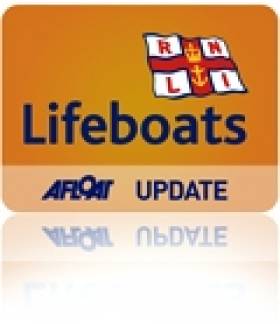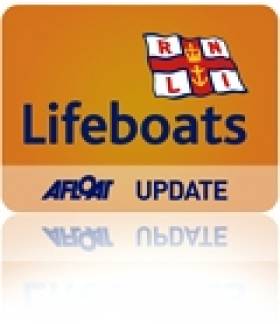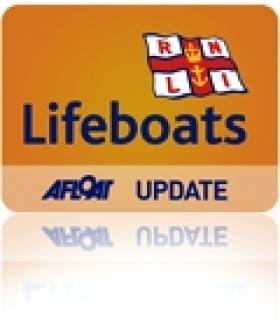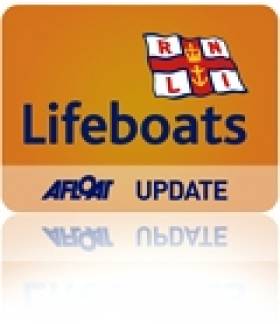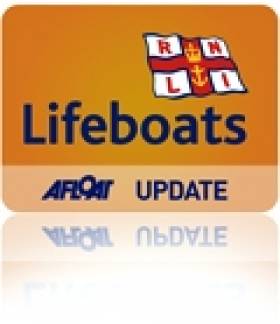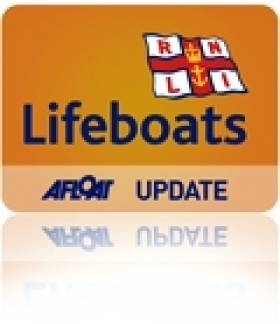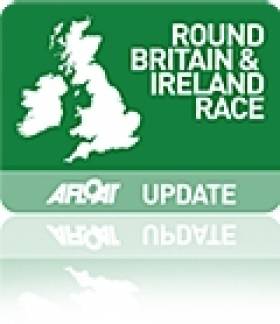Displaying items by tag: RNLI
Charlie McGibney 1928 – 2014
#rip – The sea, once it casts its spell, will hold you in the net of its wonder forever. A thought that left Dublin native Charlie McGibney spellbound for his 85 years. From a very young age and through all his journeys taken over sea and land throughout his long, distinguished and caring life, Charlie took his final journey this week after he peacefully passed away at his home in Tieraclea, Tarbert, County Kerry on February 13 last.
Born in 1928 and originally from Inchicore, Mr McGibney developed and harnessed his interest and love for the sea over many years culminating in stewardship roles with many of the countries national sailing classes and associations.
Through sailing and the his maritime links and bonds, Mr McGibney is fondly remembered throughout the community, both far and wide with the esteem his presence would hold.
A founder member and former Commodore of Tarbert Island Maritime Club, Mr McGibney held a position of governor of RNLI together with a secretariat role for the Topper International Class Association.
A regional race officer with the Irish Sailing Association, Mr McGibney was very much involved with the Mermaid Class Association. A former commodore and member of Foynes Yacht Club as well as Tralee Bay Sailing Club, the avid boat builder was never far from the sea, even in his later years at his Tarbert home.
Co owner of the class winning Dehler Optima 101 yacht 'Disaray' on Ireland's west coast, Mr McGibney was also a member of the West of Ireland Off Shore Racing Association (WIORA) of which his son Simon is Commodore. He was also involved with and a member of the historic Royal Western Yacht Club of Ireland.
Most notably in 2005, aged 77, the able seaman and mariner was the leader of the assault to the Scottish Sailing Series - Tarbert to Tarbert with three generations involved.
At 85 and the beloved husband of the late Ita, Charlie McGibney peacefully passed away leaving behind a wide circle of family and friends. He is survived by daughter Carol; sons, Thomas, George, Gerard, John Raymond, Damien, Rory and Simon, inlaews, grand children and great children.
It is to the land he may lay, but it is to the sea he will look as Mr McGibney's final resting place is at St Mary's New Cemetery following requiem mass at the adjoining church in Tarbert.
Donations, if desired to the RNLI.
Ar dheis de go raibh an anam.
Clifden RNLI Lifeboat Rescues Four Fish Farmers in Extreme Weather
#rescue – Clifden RNLI in county Galway has rescued four fish farmers after they got into difficulty in extreme weather conditions this afternoon.
The volunteer lifeboat crew was requested to launch their inshore Atlantic 85 lifeboat at 1.44pm today (Wednesday 12 February) following a request by Malin Head Coast Guard to go to the assistance of four fish farmers who were stranded at the mouth of Clifden Bay.
With the weather conditions deteriorating, the men who were working in the bay, made the call for help.
The Irish Coast Guard helicopter Rescue 118 from Sligo was also tasked.
There were westerly gusts at the time and the tide was ebbing creating a large sea state.
Due to the adverse weather conditions, the lifeboat helmed by Bernard Whelan and with crew members Kenneth Flaherty, Robert King and Thomas Davis onboard, launched from the calm side of the beach in the shelter of the shore and proceeded westward out to Clifden Bay.
Arriving on scene, the crew observed three of the fish farmers on a 16ft boat which was tied to a fish cage. The Clifden RNLI crew transferred the three men from the vessel onto the lifeboat before taking the fourth fish farmer off the large cage. The lifeboat then returned the four men safely to shore.
Speaking following the call out, Saul Joyce, Clifden RNLI Deputy Launching Authority said: 'This was a challenging call out given the gusty weather conditions the lifeboat crew was presented with today. The four casualties who are experienced fish farmers were working when the stormy conditions took over and they made the right decision to call for help. The crew used their skill and training to good effect and we are delighted to have brought all four safely back to shore.'
RNLI 'Shannon' Jet Boat is 50% Faster Than Other Lifeboats
#lifeboat – The first of the Royal National Lifeboat Institution's (RNLI) newest class of lifeboat, the Shannon, goes on station in the UK this month.
The Shannon is the first RNLI all-weather lifeboat to be powered by water jets instead of propellers, making it the most agile all-weather lifeboat in the charity's fleet. The lifeboat's water jets not only ensure it is the RNLI's most manoeuvrable all-weather lifeboat, but they also allow the Shannon to reach casualties in harder to reach places and in shallower waters.
The first boat will arrive at Dungeness lifeboat station in Kent on Friday 21 February 2014.
Capable of 25 knots, the Shannon is 50% faster than the lifeboats it will replace - meaning casualties will be reached quicker.
Lough Derg RNLI Lifeboat Rescues Kayaker After He Falls Out of Kayak
#rnli – Volunteer lifeboat crew with Lough Derg RNLI pulled a man from the Nenagh river this afternoon after they had received reports that he had fallen from his kayak and was being pushed down the fast flowing river. Members of the emergency services including the Gardai and local fire crew had tried unsuccessfully to recover the man from the side of the river and called on the RNLI lifeboat crew from Lough Derg to launch and help rescue him.
The lifeboat had to navigate the difficult waters of the Nenagh river which were strewn with debris following the recent bad weather. The kayaker was observed to be semi-conscious and was turning in the water when the lifeboat crew arrived on scene.
The RNLI volunteers spotted the man just past the Annabeg bridge. Two of the three lifeboat crew recovered the casualty over the side of the inshore lifeboat and he was immediately brought back to the station at Dromineer.
The lifeboat crew administered first aid en route. They were met by a waiting ambulance and the Coast Guard helicopter from Shannon. The paramedic gave the casualty first aid and a decision was made to transfer him by helicopter to hospital for treatment.
Commenting on the callout Lough Derg RNLI lifeboat helm Eleanor Hooker said, "This was an extremely serious situation and one where every second counted. If he had not been spotted and help had not reached him when it did he was in serious danger of being pulled under by the current. All the emergency services worked together to try and recover him as the speed with which he was being dragged down the river was increasing rapidly.
Our thoughts are with him and we hope he makes a full recovery after his ordeal.'
Smiles All Round For RNLI In SOS Day Fundraisers
#RNLI - Wicklow RNLI was delighted to welcome members of the Wicklow Kilmantin Arts Group, who presented a cheque for €500 to the station last Friday (31 January).
The money was raised during a recent art auction in Wicklow, and the local artists' group wanted some of the proceeds to go to a local charity.
Mary De Courcy, chairperson of the fundraising branch, accepted the generous donation on behalf of the station.
Speaking after the presentation, Wicklow RNLI volunteer lifeboat press officer Tommy Dover said the station was delighted to receive the gift "especially on SOS Day, one of the RNLI’s main fundraising days."
SOS Day is the annual RNLI crew fundraising day and stations all over the country host innovative and novel ways of fundraising incorporating the SOS initials.
In Northern Irelabd, supporters of Portrush Lifeboat Station jumped into the sea at Portrush Harbour and swam round the station's all-weather lifeboat, the William Gordon Burr.
The weather was bitterly cold but didn’t deter the crowd that turned up to do their bit.
- RNLI coxswain Des Austin explained: "This is a fun event that involves our crew, fundraisers, and a great local crowd who turn out irrespective of the weather to support the volunteer lifeboat crew.
"The crew themselves take part and their colleagues and on standby to give them a friendly push and also to haul them in at the end of the swim."
The man with the megaphone for the event was Robin Cardwell, Portrush RNLI lifeboat operations manager. All swimmers were counted out and counted back in again.
The crew thanked Coleraine Borough Council for their use of Waterworld for everyone to get a hot shower after their swim, as well as the RNLI lifeguards and the local coastguard team, who provided safety cover for the event.
After the event everyone was treated to homemade soup and sandwiches in Portrush Yacht Club, and a special SOS cake made by crew member Claudia McAlpin.
Bundoran Lifeboat Station Damaged Hours After Major Fundraiser
Just hours after the annual Bundoran RNLI Lifeboat dinner dance ended on Friday night, a combination of high tide and heavy swell caused damage to Bundoran Lifeboat Station.
Crew began to arrive at the lifeboat station at around 7.20am and discovered the damage as the seas had broken down the main front door as well as the bottom panel in the large doors, behind which the lifeboat is kept.
Ahead of high tide again on Saturday evening, as a precautionary measure the lifeboat was moved to higher ground but remained on service throughout the period.
Lifeboat Operations Manager for Bundoran RNLI Tony McGowan said 'despite the force of the sea, we only suffered a small amount of damage and we are happy to note that the lifeboat itself wasn't damaged and remained available for service. It was an early start following the dinner dance on Friday night and we would like to thank all of those who turned out on the morning. I would also like to point out, having viewed CCTV of the time of the impact, it was remarkable how one big surge which was at least two metres higher than the rest caused the damage. It is easy to see how people can be caught out in such conditions and I would urge people to keep well away from the water in such circumstances.'
RNLI In Dispute With Coastguard Over Trawler Emergency
#RNLI - The Irish Independent says that the RNLI wants a meeting with the Irish Coast Guard over an incident off Dublin last weekend that it was not called to attend.
According to reports, the coastguard sent its closest rescue helicopter from Dublin Airport to attend an emergency on the fishing trawler Fragrant Cloud in Killiney Bay, despite the availability of an RNLI lifeboat crew in nearby Dun Laoghaire.
More on this story as it develops.
Kilmore Quay Lifeboat Rescues Fishermen Off Saltee Islands
#RNLI - Kilmore Quay RNLI came to the rescue of two fishermen after their boat sank off the Saltee Islands in Co Wexford yesterday afternoon (Thursday 30 January).
The volunteer crew was requested to launch their all-weather lifeboat shortly after 4pm following a Mayday report that a small fishing vessel with two people on board was sinking southwest of the Saltee Islands.
Weather conditions at the time were described as overcast with a force three wind blowing.
The two casualties managed to evacuate the sinking boat onto a liferaft before being rescued by another vessel that was in the area at the time. The men were then transferred to the lifeboat and brought safely back to Kilmore Quay harbour.
RNLI Brings More Than 1,800 To Safety Across Ireland In 2013
#RNLI - RNLI lifeboats in the Republic of Ireland launched 1,087 times in 2013 bringing 1,278 people to safety.
The figures released by the charity today (Tuesday 28 January) are based on returns of service from all 44 lifeboat stations in Ireland.
And those numbers doesn't count the 245 people brought to safety in 255 launches from Northern Ireland's nine lifeboat stations - plus many more rescued by the North's RNLI lifeguards.
The statistics show that the majority of last year’s call-outs in the Republic were to pleasure craft, which accounted for 583 services, while there were 138 launches to fishing vessels.
Northern Ireland, meanwhile, counted 109 call-outs that took place in the dark, while the North's crews spent 1,459 service hours at sea collectively.
Dun Laoghaire RNLI’s all-weather and inshore lifeboats had the most launches in 2013, with its crew rescuing 67 people during 58 call-outs.
Enniskillen RNLI, which operates from two inland stations in Fermanagh, brought the most people to safety, with 82 individuals rescued from 56 call-outs. More than half of those services were carried out in the dark.
Portrush RNLI in Co Antrim had 47 call-outs, bringing 33 people to safety, while the volunteer crew in Howth launched their two lifeboats 46 times last year rescuing 78 people.
It was also a busy year for Kilmore Quay in Co Wexford, which operates a Tamar class lifeboat – the most technologically advanced in the Irish fleet. The lifeboat crew there rescued 76 people during 43 call-outs.
Further south in Co Cork, inshore lifeboat stations at Crosshaven and Kinsale launched 42 and 41 times respectively, bringing 36 people to safety in Crosshaven and 54 in Kinsale.
The charity’s lifeboat crews also had 142 call outs to people classed as ashore. These services included assisting people who were ill or injured on an island, cliff or the shoreline, where access by lifeboat was the fastest or safest way to reach the casualty.
On 10 occasions, lifeboat crews were also called upon to rescue animals in 2013. These included four dogs, two sheep, a cow, two whales and a dolphin.
In a year when Ireland saw one of its hottest summers, the overall statistics show an increase of 132 lifeboat launches in 2013, up from 955 in 2012 to 1,087. There was also an upsurge in the number of rescues with 221 more people brought to safety over the 12 month period.
In the North there was a busy season for the 10 RNLI lifeguard units, located on beaches in Co Down and along the Causeway Coast.
In all, RNLI lifeguards responded to 302 incidents compared to 159 in 2012 and came to the aid of 330 people who found themselves in difficulty, which is an increase of 153 from the year before.
The Causeway Coast, where there are seven units, was the busiest area, with lifeguards responding to 222 incidents and assisting 247 people. Among these incidents was the dramatic rescue of a family of six in Castlerock after they got caught in a flash rip - a strong current running out to sea.
Throughout the year, there were some dramatic and challenging call outs for the lifeboat crews.
In July, 30 people were rescued by Kinsale and Courtmacsherry lifeboat crews when the tall ship Astrid was blown onto rocks and started to take on water off the south coast.
Dun Laoghaire RNLI’s all-weather lifeboat and Howth RNLI’s inshore lifeboat rescued six people on Dublin Bay in August after their boat capsized and they were left clinging to the upturned hull.
And in September, Portaferry RNLI rescued a fisherman from Portavogie, who was in the water for 45 minutes after his vessel sank off the coast of Co Down.
Reflecting on the year, RNLI operations manager for Ireland Martyn Smith said: "2013 proved to be another busy year for the RNLI with an increase in both our lifeboat launches and rescues.
"Our lifeboat crews are highly trained and equipped to deal with the challenges they face and we are indebted to their dedication to respond when the need arises.
He added: "Sadly not every call out results in a rescue and 2013 also brought its share of tragedy. A number of our call-outs involved searches for missing people and in some incidents, they involved bringing home loved ones who were lost at sea.
"These call-outs, while challenging for all involved, demonstrate the commitment and seamanship of our crews who devote many hours to a search and recovery effort."
Looking ahead, Smith reminded the public that irrespective of weather conditions, the water always presents a risk.
He recommended that people take care by following some simple safety tips: "We would remind water users to always wear a lifejacket, get the appropriate training, carry a means of calling for help, check engine and fuel, tell others where you are going and check weather and tides."
Smith also took time to thank everyone who contributed to helping the RNLI save lives at sea in 2013.
"I would like to say a huge thank-you to our volunteers and all those who support the RNLI, a charity dependent on the generosity of the public, whether by giving up their time or by making a donation.
"I would also like to acknowledge the efforts of our colleagues in the Irish Coast Guard and emergency services who we worked closely with in 2013."
RNLI Is Charity Partner For Round Britain & Ireland Race 2014
#RB&I2014 - The Royal Western Yacht Club of England announced today (Friday 24 January) that the RNLI is the chosen charity partner for the 2014 edition of the Round Britain and Ireland Race.
The two-handed event, which will start on 1 June, is run every four years and first began back in 1966. The race starts and ends in Plymouth with stopovers in four ports, each with an RNLI lifeboat station.
Entries are now being accepted for the race, which is open to all yachts and multihulls between 30 and 50 feet in length and crewed by two people only.
The event has become an international classic, attracting many famous names over the years. Race Director Alan Nichols says: "The course runs clockwise around all of Great Britain and Ireland with compulsory stops at Kinsale, Barra, Lerwick and Lowestoft where the hospitality is legendary.
"It is a huge test of endurance and seamanship and definitely not for the faint hearted. In fact we require entrants to complete a qualifying voyage before their final entry is accepted."
Nichols adds that the RNLI "has a vital presence in Plymouth and each of the stopover ports and it seemed entirely appropriate that we should invite the charity to join us as our partner for the 2014 event.
"Their volunteers are our guardians if you like and those of us who enjoy such racing appreciate knowing that they are on standby to help us 24 hours a day and seven days a week. The RNLI also believe in prevention rather than cure and we hope our joint belief in safety at sea will be reinforced by this liaison."
Entries are now open for the race with all the relevant details available on the Royal Western Yacht Club website HERE.
"We’ve already received some early entries so I would urge people not to leave it too late to express an interest in competing," says Nichols. "In the meantime, there are a number of sponsorship opportunities for businesses wanting to become involved in this iconic event."
Interested companies should contact the Royal Western Yacht Club at +44 (0) 1752 660 077.
Meanwhile, RNLI community fundraising manager Guy Botterill says the partnership between the race and the charity is clear.
"There’s the RNLI presence at each of the ports the race goes to, the obvious belief on both sides that safety at sea is paramount and the fact the RNLI will be there if anyone does get into trouble.
"What’s more the race has in the past attracted entries from RNLI people, including Pip Hare, who works for our coastal safety department in Poole, and Adam Littlejohn, who is based in the southwest and works for our shoreworks department.
"I’d like to thank the Royal Western Yacht Club for this very kind invitation to be the charity partner and we look forward to a successful association before, during and after the 2014 event."



























